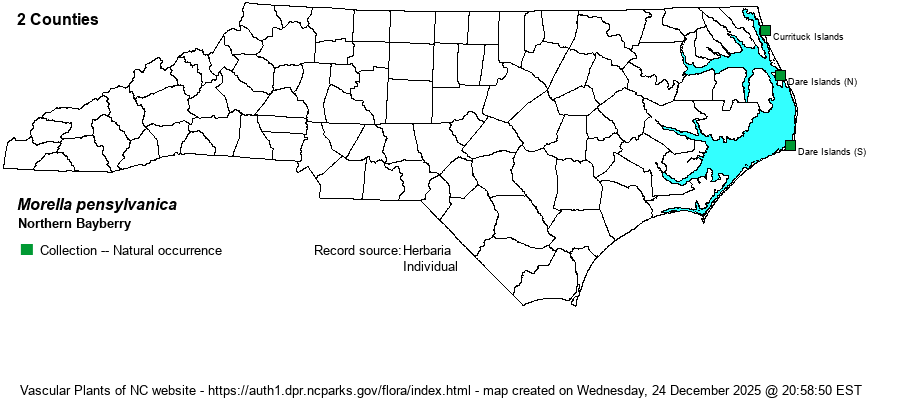| Section 6 » Order Myricales » Family Myricaceae |
Show/Hide Synonym
| taxonName | relationship | relatedTaxonName | relatedTaxonRefText | relComments |
|---|
|
|
|
| Morella pensylvanica | = | Myrica pensylvanica | Gleason and Cronquist (1991) | | | Morella pensylvanica | = | Myrica pensylvanica | Fernald (1950) | | | Morella pensylvanica | = | Myrica pensylvanica | Flora of North America (1993b, 1997, 2000, 2002a, 2002b, 2003a, 2004b, 2005, 2006a, 2006b, 2006c, 2007a, 2009, 2010) | | | Morella pensylvanica | = | Myrica pensylvanica | Godfrey and Wooten (1979, 1981) | | | Morella pensylvanica | = | Myrica pensylvanica | | | | Morella pensylvanica | = | Myrica pensylvanica | Radford, Ahles, and Bell (1968) | | | Morella pensylvanica | = | Myrica pensylvanica | | | | Morella pensylvanica | < | Myrica pensylvanica | Gleason (1952) | | | Morella pensylvanica | < | Cerothamnus carolinensis | Small (1933, 1938) | | | Morella pensylvanica | < | Morella caroliniensis | Kubitzki in Kubitzki, Rohwer, & Bittrich (1993). | | | Morella pensylvanica | = | Cerothamnus pensylvanicus | | | | Source: Weakley's Flora |
|
| Author | (Mirbel) Kartesz | |
| Distribution | Limited only to the northern barrier islands of the state, south to the Avon area in Dare County.
This is a Northern species with a limited distribution in the U.S., but is more widespread in Canada. Most of the U.S. range lies close to the coast, south to NC, and inland to MI and OH.
| |
| Abundance | Uncommon to locally common in its narrow range in Currituck and the northern 2/3rds of Dare County. Not hard to find on dunes, though development of dunes and sand flats is certainly still squeezing its habitat. | |
| Habitat | This species in NC is limited to dunes and sand flats, mostly within sight of the ocean. It also grows on sand flats behind the main dune line. | |
| Phenology | Flowers in April, and fruits in August and September. | |
| Identification | This is a medium-sized deciduous (to tardily deciduous) shrub of specialized sand habitats. It grows mostly to about 5-6 feet tall, but at times to 10 feet tall; and it is often much wider than tall. The alternate leaves are rather thick and widely oblanceolate, about 3 inches long and about 1-1.5 inches wide, shaped essentially like those of M. caroliniensis, with a few teeth toward the tip. Unlike that species, Northern Bayberry has pale gray to ashy pale brown twigs (as opposed to dark brown to black). In its range, it can only be confused with the abundant M. cerifera, which grows in wet areas very close to this species. However, M. cerifera has evergreen leaves that are narrower and thinner in texture, and its fruits are smaller. By early winter, M. pensylvanica will have dropped all or nearly all of its leaves. Where the dunes have not been impacted by development, this is often the most common shrub (at least taller than 6 feet high) on them. | |
| Taxonomic Comments | All members of the genus Morella were formerly included within the genus Myrica (i.e., Myrica pensylvanica). It is not clear why most plant and animal species named after the state of Pennsylvania have dropped the double “nn” in favor of a single one. However, once a species is first described, the spelling of the name essentially cannot be changed, which is silly, as species are constantly being moved from one genus to another, or from one species name to another (e.g., Morella heterophylla to Morella caroliniensis).
| |
| Other Common Name(s) | Often called just “Bayberry”, but as there are other species in the genus, this name needs a modifier. Other name: Candleberry | |
| State Rank | S3 | |
| Global Rank | G5 | |
| State Status | | |
| US Status | | |
| USACE-agcp | FAC link |
| USACE-emp | FAC link |

